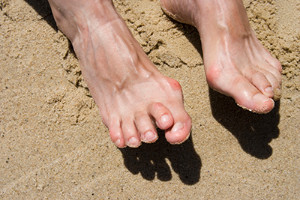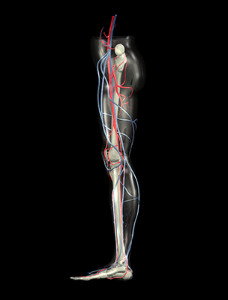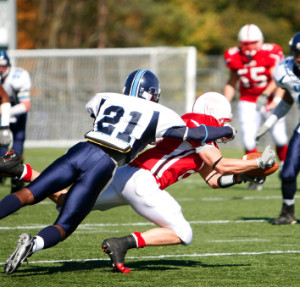Blog
Understanding Hammertoes
 If you have hammertoes, it may be due to a number of factors including improperly-fitting shoes or muscle and nerve diseases that can affect your feet. Hammertoes are described as bent and curled toes, seeming to resemble the claw of a hammer. The condition is permanent and may require treatment if pain progresses. Typical treatment includes wearing the proper footwear and physical therapy. A final option is surgery for severe cases, but consulting with your podiatrist first about your condition is recommended before deciding on the surgical option.
If you have hammertoes, it may be due to a number of factors including improperly-fitting shoes or muscle and nerve diseases that can affect your feet. Hammertoes are described as bent and curled toes, seeming to resemble the claw of a hammer. The condition is permanent and may require treatment if pain progresses. Typical treatment includes wearing the proper footwear and physical therapy. A final option is surgery for severe cases, but consulting with your podiatrist first about your condition is recommended before deciding on the surgical option.
Hammertoe
Hammertoes can be a painful condition to live with. For more information, contact one of our podiatrists from Pennsylvania. Our doctors will answer any of your foot- and ankle-related questions.
Hammertoe is a foot deformity that affects the joints of the second, third, fourth, or fifth toes of your feet. It is a painful foot condition in which these toes curl and arch up, which can often lead to pain when wearing footwear.
Symptoms
- Pain in the affected toes
- Development of corns or calluses due to friction
- Inflammation
- Redness
- Contracture of the toes
Causes
Genetics – People who are genetically predisposed to hammertoe are often more susceptible
Arthritis – Because arthritis affects the joints in your toes, further deformities stemming from arthritis can occur
Trauma – Direct trauma to the toes could potentially lead to hammertoe
Ill-fitting shoes – Undue pressure on the front of the toes from ill-fitting shoes can potentially lead to the development of hammertoe
Treatment
Orthotics – Custom made inserts can be used to help relieve pressure placed on the toes and therefore relieve some of the pain associated with it
Medications – Oral medications such as anti-inflammatories or NSAIDs could be used to treat the pain and inflammation hammertoes causes. Injections of corticosteroids are also sometimes used
Surgery – In more severe cases where the hammertoes have become more rigid, foot surgery is a potential option
If you have any questions please contact one of our offices located in Plymouth Meeting and Ambler, PA . We offer the newest diagnostic and treatment technologies for all your foot and ankle needs.
Preventing Poor Blood Circulation
 If your feet feel cold, especially during these winter months, it is because it is your body’s natural response for conserving heat when it is too cold. Your body “tries to maintain its internal temperature by constricting small blood vessels under the surface of the skin. This allows more blood to move deeper in the body, so your core stays warm.” However, this causes your body’s extremities, like the feet, to receive poor blood circulation. When taking care of your cold feet, try to wear warm, breathable socks that help wick away moisture. Opt for wool in place of cotton. Other methods include warming your feet up in warm water, drinking hot liquids, moving around to get your blood circulation going, and investing in shoe inserts to help insulate the insides of your shoes.
If your feet feel cold, especially during these winter months, it is because it is your body’s natural response for conserving heat when it is too cold. Your body “tries to maintain its internal temperature by constricting small blood vessels under the surface of the skin. This allows more blood to move deeper in the body, so your core stays warm.” However, this causes your body’s extremities, like the feet, to receive poor blood circulation. When taking care of your cold feet, try to wear warm, breathable socks that help wick away moisture. Opt for wool in place of cotton. Other methods include warming your feet up in warm water, drinking hot liquids, moving around to get your blood circulation going, and investing in shoe inserts to help insulate the insides of your shoes.
Poor circulation is a serious condition and needs immediate medical attention. If you have any concerns with poor circulation in your feet contact one of our podiatrists of Pennsylvania. Our doctors will treat your foot and ankle needs.
Poor Circulation in the Feet
Poor blood circulation in the feet and legs is can be caused by peripheral artery disease (PAD), which is the result of a buildup of plaque in the arteries.
Plaque buildup or atherosclerosis results from excess calcium and cholesterol in the bloodstream. This can restrict the amount of blood which can flow through the arteries. Poor blood circulation in the feet and legs are sometimes caused by inflammation in the blood vessels, known as vasculitis.
Causes
Lack of oxygen and oxygen from poor blood circulation restricts muscle growth and development. It can also cause:
- Muscle pain, stiffness, or weakness
- Numbness or cramping in the legs
- Skin discoloration
- Slower nail & hair growth
- Erectile dysfunction
Those who have diabetes or smoke are at greatest risk for poor circulation, as are those who are over 50. If you have poor circulation in the feet and legs it may be caused by PAD and is important to make changes to your lifestyle in order to reduce risk of getting a heart attack or stroke. Exercise and maintaining a healthy lifestyle will dramatically improve conditions.
As always, see a podiatrist as he or she will assist in finding a regimen that suits you. A podiatrist can also prescribe you any needed medication.
If you have any questions please feel free to contact one of our offices located in Plymouth Meeting and Ambler, PA . We offer the newest diagnostic and treatment technologies for all your foot and ankle needs.
HFM Disease Found in Children in California
 Students at an elementary school in Desert Hot Springs, California were found to have contracted the virus Coxsackie, also known as hand, foot, and mouth disease. As the disease is highly communicable, a notification was sent out to parents of the students that could be exposed. The symptoms are rashes and blisters in the mouth, on the palms of the hands, and on the soles of the feet. It might be difficult to walk and there is typically an accompanying fever. If you develop blisters on your feet it is important that you try to keep them from rupturing, as the disease is spread through the fluid.
Students at an elementary school in Desert Hot Springs, California were found to have contracted the virus Coxsackie, also known as hand, foot, and mouth disease. As the disease is highly communicable, a notification was sent out to parents of the students that could be exposed. The symptoms are rashes and blisters in the mouth, on the palms of the hands, and on the soles of the feet. It might be difficult to walk and there is typically an accompanying fever. If you develop blisters on your feet it is important that you try to keep them from rupturing, as the disease is spread through the fluid.
When dealing with systemic disease of the feet, it is extremely important to check the affected areas routinely so that any additional problems are caught quickly. If you have any concerns about your feet and ankles contact one of our podiatrists from Pennsylvania. Our doctors will assist you with all of your podiatric needs.
Systemic Diseases of the Feet
Systemic diseases affect the whole body, and symptoms usually are displayed in the feet. This condition can make a patient’s ability to walk unbearable. Systemic diseases include gout, diabetes mellitus, neurological disorders, and arthritis.
Gout – is caused by an excess of uric acid in the body. Common symptoms include pain, inflammation, and redness at the metatarsal/phalangeal joint of the base big toe. Gout can be treated by NSAIDs to relieve pain and inflammation, and other drugs that lower the acid levels in the body.
Diabetes mellitus – is an increase in the level of blood sugar that the body cannot counteract with its own insulin. Failure to produce enough insulin is a factor in Diabetes.
Diabetes of the Feet
Diabetic Neuropathy – may lead to damaged nerves and affect the feet through numbness and loss of sensation.
Peripheral Vascular Disease – can restrict the blood flow to the feet, and often times lead to amputation of the feet.
If you have any questions please feel free to contact one of our offices located in Plymouth Meeting and Ambler, PA . We offer the newest diagnostic and treatment technologies for all your foot and ankle needs.
Hard Surfaces Contribute to Foot and Ankle Injuries
 Athletes who play on hard surfaces, such as basketball players or tennis players, typically participate in sports that often give their feet a harsh workout. Fast and rough movements can contribute to foot and ankle injuries such as plantar fasciitis, ankle sprains, stress fractures, bone spurs, and Achilles tendon issues. Many of these injuries can be prevented by proper stretching, wearing proper footgear appropriate for the sport, and wearing orthotics as needed. For younger athletes, heel pain should be monitored. The heel growth plate is especially vulnerable to injury for growing children. If pain persists, activity should be stopped immediately.
Athletes who play on hard surfaces, such as basketball players or tennis players, typically participate in sports that often give their feet a harsh workout. Fast and rough movements can contribute to foot and ankle injuries such as plantar fasciitis, ankle sprains, stress fractures, bone spurs, and Achilles tendon issues. Many of these injuries can be prevented by proper stretching, wearing proper footgear appropriate for the sport, and wearing orthotics as needed. For younger athletes, heel pain should be monitored. The heel growth plate is especially vulnerable to injury for growing children. If pain persists, activity should be stopped immediately.
Sports related foot and ankle injuries require proper treatment before players can go back to their regular routines. For more information, contact one of our podiatrists of Pennsylvania. Our doctors can provide the care you need to keep you pain-free and on your feet.
Sports Related Foot and Ankle Injuries
Foot and ankle injuries are a common occurrence when it comes to athletes of any sport. While many athletes dismiss the initial aches and pains, the truth is that ignoring potential foot and ankle injuries can lead to serious problems. As athletes continue to place pressure and strain the area further, a mild injury can turn into something as serious as a rupture and may lead to a permanent disability. There are many factors that contribute to sports related foot and ankle injuries, which include failure to warm up properly, not providing support or wearing bad footwear. Common injuries and conditions athletes face, including:
- Plantar Fasciitis
- Plantar Fasciosis
- Achilles Tendinitis
- Achilles Tendon Rupture
- Ankle Sprains
Sports related injuries are commonly treated using the RICE method. This includes rest, applying ice to the injured area, compression and elevating the ankle. More serious sprains and injuries may require surgery, which could include arthroscopic and reconstructive surgery. Rehabilitation and therapy may also be required in order to get any recovering athlete to become fully functional again. Any unusual aches and pains an athlete sustains must be evaluated by a licensed, reputable medical professional.
If you have any questions please feel free to contact one of our offices located in Plymouth Meeting and Ambler, PA . We offer the newest diagnostic and treatment technologies for all your foot and ankle needs.
